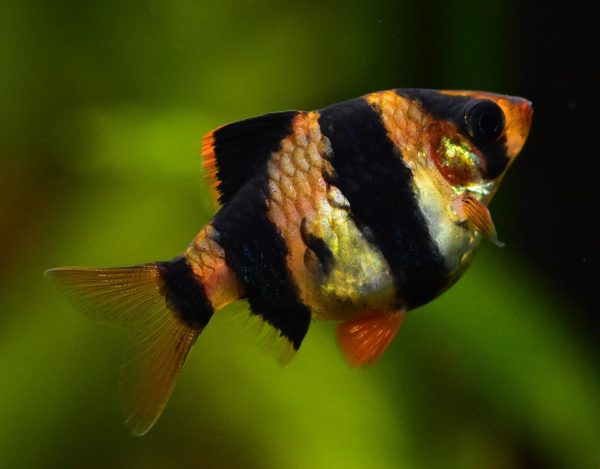What can be better than buying new fish for the aquarium, right? Today we are going to discuss the fish species called a Tiger Barb. So if you are thinking of buying these fish species but don’t have much information about them, this article is perfect for you. We will share all the information about the diet, behavior, and many other aspects of Tiger Barbs.
Table of Contents
Tiger Barb Overview
| Family | Cyprinidae |
| Species | Puntius tetrazona |
| Common Name | Sumatra barb, Green tiger barb, Tiger barb, Black Tiger Barb, Albino Tiger Barb |
| Range | Indonesia, Sumatra, Borneo |
| Size | Up to 3 inches |
| Lifespan | 5 to 7 years |
| Color | Silver or gold with four black bands |
| The temperament of Tiger barb | Semi-aggressive |
| Diet of Tiger barb | Omnivorous, Frozen foods, Live foods, Flakes, Pellets |
| Tank Set-up | Freshwater, Rocks, plants, driftwood, gravel substrate at the bottom |
| Tank Conditions | 74-79°F; pH 6.0-7.0; dH 4-10 |
| Minimum Tank Size | 30 gallons |
| Light level | Low |
| Care Level | Easy |
| Breeding of Tiger barb | Egg Layer |
| Suitability | Good |
| Community | When cultivated in groups to prevent fin nipping |
General Information
The scientific name of Tiger barb is Puntigrus tetrazona or Barbus tetrazona, and it belongs to the Cyprinidae family, including Minnows, Chubs, and Carps. Alternatively, it is called Sumatra Barb. These species are available anywhere, starting from $2 to $5; cost varies based on the color, quantity, and size.
These fishes originate in Indonesia, Borneo, Sumatra and naturally found in the regions of southeast Asia. These species are active swimmers and occupy the entire tank.
The tiger barbs are freshwater fish that grow a maximum of 3 inches and live somewhere between 5-10 years. These are enjoyable and colorful types of fish and are perfect for keeping in the tank. Overall these fish are gray and have black stripes across the body. Because of this appearance, it was named tiger barb. A healthy tiger barb has a brighter color and has red fins.
Other color variations are also witnessed in these species due to selective breeding like albino, green, black, and red. Tiger barbs are egg layers with no parenting skills who prefer to eat rather than care for their eggs. As a result, the best approach to breed them is to use artificial hatching.
- Albino: This fish body is available in light orange with white stripes
- Green: This fish body is available in green color, and the fins will be in orange and black color
- Longfin: This fish has flowy fins that are longer than usual
- GloFish: These fishes are fluorescent colored like electric green, purple, and more are called GloFish.
Tiger Barb Appearance
Tiger Barbs are tiny, reaching a maximum length of 2.5 inches, and attain maturity within 6 months or a year. In 3 months, gender identification can be made. They have pointy triangular snouts and large flaring bodies, resembling barbs or spear points.
Females are slightly larger than males, with rounded bodies and duller hues, while males are more streamlined, with brighter colors and patterns.
A typical Tiger Barbs coloring and patterns match the tiger, after which it is named: golden yellow with four influential black bands and brilliant orange markings on the snout and fins. However, there are now numerous breeds and color forms of Tiger Barbs available. Their scales come in various colors: gold, crimson, pale silver, and green. They may have solid bands, fractured bands, or none at all.
Depending on the diet supplements and feeding conditions, the species’ color changes. Male species appear in bright colors attracting female mates.
The behavior of Tiger Barb
Generally, these fishes can be a bit aggressive, so there is a possibility that they may harm the other slower species in their tanks like they will rip the fins off other slower fish. So it is not recommended to keep them in a community tank.
These fish are fiercely combative and will create little hierarchies to fight dominance. They are gregarious, lively fish who enjoy being in public. In the center of your tank, you can see them chasing, bumping, and nipping at each other.
They must be kept in a group of at least five people, though they prefer no fewer than eight and no more than twelve. They are more inclined to harass other tank mates when maintained in a small group.
Although if you are thinking of keeping them in a community tank, provide many Tiger barbs in the tank. They feel better when they are around their species. That’s why they consider keeping a Tiger barb in their groups. But overall, these are very playful fish species that people love to watch.
Tank requirements for the Tiger Barb
As these are smaller fish species, you do not need large tanks to keep a group of Tiger barbs. However, these are very active fish, who love to swim fast, so they need a space for that. The minimum tank size should be 30 gallons for Tiger barbs.
The tank temperature should be between 75 – 80 degrees Fahrenheit (23 – 27 Celcius), and the hardness level of water should be up to 10 dGH and a pH of between 6 and 7.
Tank Set-Up for the Tiger Barb
Fine gravel should be used as the substrate with huge rocks and cobbles for shelter. Tiger Barbs can live in various depths and light conditions so a simple aquarium hood light will suffice.

Low-flow or under gravel filters can simulate Barbs’ modest currents in their native habitats. Freshwater plants and algae submerged in the water provide shelter, breeding grounds, and extra nourishment. On the other hand, these fish prefer free water to swim in; thus, their tank should not be overly planted.
Plants should be placed on the tank’s sides and corners, leaving the middle clear for free swimming.
Lightning
Tiger barbs require less lighting, so you can use natural light by placing your fish tank in an open area. However, in an indoor context, an artificial supply would be sufficient to ensure that plants and animals receive the nutrients they require to be healthy. You can use a 40-W fluorescent aquarium light or a 150-W aquarium light as an example. Set up both light sources to provide adequate illumination without producing excessive heat.
Diet of Tiger Barb
Tiger Barbs are omnivorous fish species. You can feed them with almost anything. But feeding with a balanced nutritional diet, including meat-based and vegetable foods, will help them grow stronger and healthier.

Diet for the Tiger Barb can be both available in the form of commercial and homemade foods.
Commercial/Prepared home foods
Feeding the Tiger Barb with pre-prepared food includes
- Flakes
- Pellets
- Live Foods
- Frozen Foods
- Freeze-dried Foods
Flakes
Feeding with flakes will enable the fish to meet the required nutritional value. Choosing high-quality products like TetraMin Tropical Flakes will supply the essential ingredients required for the optimal health of the fish.
Pellets
Pellets are another commercial feeding option for tiger barbs. Pellet meals, such as the New Life Spectrum blend meat-based foods (krill, herring, squid, and New Zealand mussel protein) with vegetable extract (spirulina, microalgae, spinach, peas, zucchini, apricot, papaya, and so on) to produce a color-enhancing and immunologically food for your tiger barbs.
Live Foods
Live foods like brine shrimp and bloodworms are favorites for tiger barbs. This food is essential during the time of breeding. Live foods are high in nutrients vital for your fish’s health; however, you should be cautious about where you get them because they may include parasites that can infect your fish.
You can also make your own cultures, which is suggested, especially when feeding tiger barb fry, which can only eat newly hatched brine shrimp.
Frozen Foods
Frozen brine shrimp and bloodworms are other options for tiger barbs, and while they don’t have the same nutritional value as live foods, they’re a good substitute.
Frozen-dried foods
Freeze-dried foods are a healthier alternative than live foods, as live foods carry a danger of transmitting infections. Freeze-dried foods are safe for your tiger barbs because the freeze-drying process kills parasites and other germs.
Before offering freeze-dried items to your fish, soak them in a bit of aquarium water so they don’t grow in their bellies and cause intestinal problems.
Home-Made Foods
Let’s look at some of the best home-cooked dishes for tiger barbs.
You can feed your fish at home if you have the time and desire. You can soft-boil veggies like zucchini or produce beef heart paste at home, a nutritionally superior dish.
Fresh beef heart, vegetables (peas, spinach, carrots, etc. ), raw peeled shrimp, and unflavored gelatin for consistency are necessary ingredients for making beef heart paste.
Blend the ingredients in a food processor, add the gelation according to the packet instructions and freeze the paste in ice cube trays. Cut out the frozen paste meal portions to feed your tiger barb fish.
If you’re feeding beef heart paste to tiger barbs for the first time, then experiment first by giving small portions to your fish.
Tank Mates for Tiger Barb
As mentioned above, Tiger Barbs aren’t the best fish species to keep in a community tank. But if you have at least 5-6 Tiger Barbs in one tank, they will not be as aggressive as when kept alone in a community tank.
It is not recommended to keep them with fish with long fins or very slow as they rip their fins off.
Species that are not compatible with tiger barb species are
- Angelfish
- Bettas
- Cichlids
- Bettas
- Goldfish
Some suitable species are
- Zebra Danios
- Black Ruby Barbs
- Red-Tailed Shark
- Cherry Barb
- Rosy Barbs
- Cory Catfish
- Tinfoil Barb
- Clown Loach
- Plecos
- Pictus Catfish
Breeding of the Tiger Barb
Breeding the Tiger Barb can have quite a few difficulties. Tiger barb generally chooses different partner mates for every spawning. Tiger barbs can spawn multiple times, and they reach maturity at 5 to 6 weeks of age. If they spawn under the submerged vegetation, the tiger barb can produce 500-600 eggs per spawning.
But if you have decided to breed them, you need to take the following actions. Tiger barbs love to eat their eggs, so to avoid that, the tank should be filled with plants and have a marbled bottom where the eggs will get lost, and they won’t be able to eat the eggs.
To prepare them for breeding, you can take the male fish to keep them in a different aquarium for up to 5 days. Female Tiger barbs need to be kept in a large aquarium with a marble bottom. The temperature of the water in the tank should be 80F degrees. And you need to feed the female fish with complete protein food and change the 30% of tank water every day.
When you notice a pregnant female fish, you can bring them back to the breeding tank to keep them with the males. The Pregnant female fish have a larger and rounder belly, while their fins will be darker.
Tiger Barbs lay around a hundred eggs; during this process, the males follow the eggs to fertilize them all. This is when you should try to hide the eggs from adults.
The fry will grow after a week and swim after 5 days of hatching. It is recommended to feed them with all-liquid food or mashed brine shrimp.
Gender Determination
Before expecting the eggs from the fish, the gender should be determined. In the initial stages, gender determination is possible; after attaining sexual maturity, it is difficult to judge gender.
Physical Traits for Female Tiger Barbs
- Anal fins will go straight down
- Female tiger barbs have round bellies
- The ventral fins are in red or orange color
- They exhibit significantly fewer colors.
Physical Traits For Male Tiger Barbs
- The male tiger barbs look very carefully.
- To identify the male tiger barb, a bright red nose is one of the indications.
- Ventral fins are colored in bright red
- It has a slim body
Conditioning
Conditioning your tiger barbs will prepare quality eggs and fry for breeding. The tiger barbs are placed in a separate tank and fed with a proper diet in this process. Diet includes brine shrimp, bloodworms, tubifex, and other protein-rich food sources.
Hatching
To hatch the eggs, they should be placed in a separate container, and the water in the tank should meet the parameters of the breeding tank. The water should be treated with methylene blue to avoid the origin of the fungus.
Caring For Tiger Barb Fry
The stage after the hatching is called larvae stage. In this stage, the Tiger barb will feed on the yolk sac. After observing the yolk sacs absorbed and larvae start swimming, from this moment, we should start feeding the tiger barb babies. But don’t overfeed the babies; feeding with brine shrimp 3-4 times a day will be sufficient. In minute quantities, start feeding them with the commercial fry foods. Move the tiger barbs to other tanks once the babies are habituated with the commercial fry foods.

Other Considerations
Tinfoil barbs come in several colors that frequently school together, making it simple to create a personalized rainbow or single-color school. However, breeding is difficult in a regular aquarium, which is beneficial for hobbyists who do not want to add more barbs. However, if you want your fish to reproduce, this can be aggravating. Because tinfoil barbs are infamous for jumping out of aquariums, they must be housed in a tank with a top cover.
Common Diseases of Tiger Barbs
Tiger Barbs do not have any specific disease, but they can have more of the usual diseases, for instance, dropsy, fin rot, velvet, Gill Fluxes, and ich.
When the fish are susceptible to itch, you can observe a few white dots on their skin and fins. Itching usually occurs due to poor maintenance of the tank and water quality. You can treat affected fish by isolating them in a separate fish tank with clean water.
Dropsy
This disease occurs in fish as a result of bacterial infection. The common symptoms include a swollen belly, protruding scales, and rapid breathing.
Fin Rot
This disease occurs on the fish fins due to bacterial infection. The leading cause of this disease is improper cleaning and periodic maintenance of the tank. Difficulty in swimming tattered fins is primarily observed in the affected fishes. Treating with the proper antibiotics during the early stages will treat the disease.
The primary reason for the illness is improper diet. So feeders should learn about the type of food to be included in the diet to provide essential nutrients.
Velvet
The parasites will attack the fish body and develop to, if it is not identified in the early stages it leads to fatal. The affected fish will look like a yellow or light brown film on its body.
Gill Flukes
Parasites cause this disease; it mainly affects the fish gills and is widely seen on skin fish. It can be cured by treating with anti-worm medication.

The best way to avoid these diseases is to keep ideal water in the tank; this should be enough to keep your Tiger Barbs healthy. Also, remember that filtration is one of the main factors in keeping a fish healthy in the tank.
Advantages of having the Tiger Barb
We can avail of the below advantages by choosing the Tiger Barb Species.
- Adds beauty to the aquarium
- Starter Experience
- Business Development
Adds beauty to the Aquarium
They come in various complexions and traits, and each one is unique. For example, Sumatra barbs have a gold base with four black or dark green stripes. Another species, known as the Glass Tiger Barb, has a near-transparent yellow tint, making the belly, wherein internal organs are located, appear crimson.
To put it another way, they’re all stunning. They’re also entertaining to watch when they swim in a group. They’ll be a terrific investment and a gorgeous sight in your aquarium, which is one of the advantages of keeping Tiger Barb fish.
Starter Experience
As the tiger barbs are easy to take care of, maintaining them properly will help gain experience. Their life expectancy is just 7 years, provided with proper care like efficient nurturing, a clean tank environment, optimal water conditions, and a rich diet.
Business
One of the advantages of keeping Tiger Barb fish is that the female can generate many eggs in single breeding. As a result, you can turn your new fish into a company. Try this marketing gimmick: inform your consumers that they should buy more than 6 fish in one transaction because Tiger Barbs’ aggressive temperament will work dangerously beneath that number.
FAQ’s
Are Tiger Barbs Best Suited For Aquariums?
These small fishes will burn bright in your aquarium with eye-catching colors, black stripes, and energetic behaviors.
They are gregarious, playful, and entertaining to watch, and they look lovely in a tropical tank. Those who take them on must be willing to limit their fin-nipping and maintain a balanced, nutritious diet.
Caregivers who have some experience with tropical freshwater fish should find that caring for them is a pleasurable experience. In comparison to other species, they require less maintenance.
Do Tiger Barbs Require Oxygen?
Maintain tropical water temperatures of 75 to 82 degrees Fahrenheit in your Barb tank, with a pH of 6.0 to 8.0. Tiger barbs can live in various depths and light levels so a simple aquarium hood light will suffice.
Do Tiger Barbs Eat Each Other?
As the Tiger Barb is an omnivore fish, maintaining them will not be a problem. They’ll eat almost anything your other fish eats.
Conclusion
So, what do you think? Are Tiger Barbs right for you? Hopefully, you got all the information you needed about these fishes. Just remember to follow all the requirements, and they will be a great addition to your tank. Don’t forget to keep them in large groups. Suppose you are looking for playful, fun, and fast-moving fish that will always keep the tank in action, then Tiger Barb is a perfect option for you. And remember that the only way to keep them happy and healthy is to provide them with the best quality water with good filtration.
No related posts.
